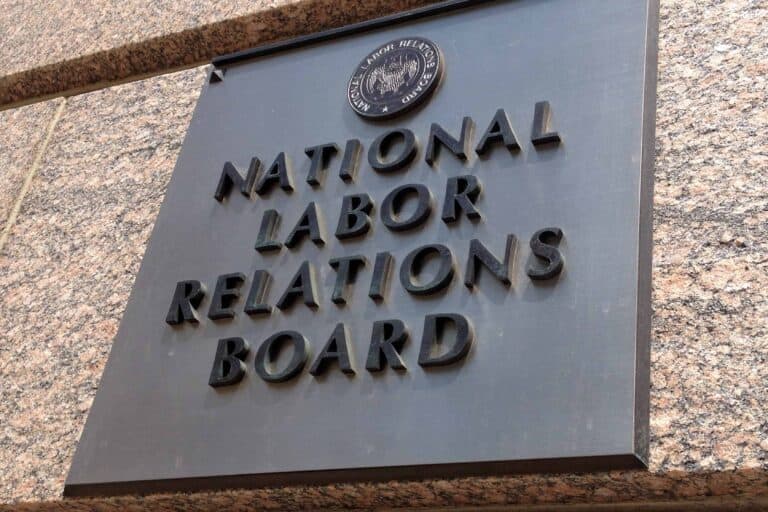Anita Alem is a student at Harvard Law School.
Organizing in break rooms and cafeterias has been a key strategy of the Amazon Labor Union and contributed to its successful Staten Island union election. But as the Albany facility election approaches, Amazon is enforcing a policy that prohibits employees from being inside facilities more than 15 minutes before or after their shift, and bars off-duty employees from entering facilities altogether. This latest fight at Amazon highlights an opportunity for the NLRB to bolster off-duty access rights, which have remained largely stagnant for nearly 50 years.
The Tri-County Rule and the Exterior-Interior Distinction
Access rights to employer property are a critical flashpoint for organizers, who seek to engage with workers at their worksite. Indeed, Amazon’s own leaked managerial training video cited the presence of off-duty employees in the break room as a “warning sign” of unionization. At the same time, the United States has a long tradition of deference to property rights. The Board and the Supreme Court have repeatedly attempted to balance these conflicting rights, depending on the status of the person seeking access: nonemployee or employee, and within the latter, on-duty or off-duty.
In Republic Aviation, the Court recognized that the NLRA gives employees an affirmative right to organize on employer property during non-work time, absent legitimate business justification. However, the Court later distinguished nonemployee organizers, finding they have virtually no right to enter employer property, a principle it recently reaffirmed in Cedar Point. The NLRB initially found that an off-duty employee is “more nearly analogous to that of a nonemployee,” and upheld an employer policy reminiscent of Amazon’s that stated “[a]n employee is not to enter the plant or remain on the premises unless he is on duty or scheduled for work.” Although the Board quickly backtracked from equating nonemployees with off-duty employees, it still settled on a compromise that significantly limited access rights. Under Tri-County, an off-duty no-access policy is valid if it: 1) limits access only to the interior of the plant and other working areas; 2) is clearly disseminated to all employees; and 3) is applied non-discriminatorily across all off-duty employees and not merely those engaging in union activity.
In other words, Tri-County draws a line between exterior versus interior non-work locations, requiring that off-duty employees be permitted access to the parking lot, but allowing them to be barred from the break room, without justification — even if these employees regularly enter facilities to work, and in fact, may have even been inside only minutes earlier.
The 1976 decision suffers from two significant doctrinal flaws. First, it gives undue power to employer property interests in the face of an affirmative statute. An employee’s NLRA rights do not diminish when they are off the clock. The test, therefore, presumes that an employer’s property interests in excluding any individual worker from interior facilities increase immediately outside of that worker’s shift, and that the NLRA does no work at all in balancing against that interest. Moreover, the rule enables employers to easily disguise anti-union animus as property rights, without any legitimate justification.
Second, the no-access principle draws an arbitrary line between the interior and exterior of a facility. By “limit[ing] access solely with respect to the interior of the plant and other working areas,” the first prong of Tri-County identifies the entire interior of a facility as a working area. This conception of employer property stands in tension with precedent regarding on-duty employee access and union literature distribution that clearly contemplates a right to access interior, non-work areas like break rooms. There is no coherent doctrinal explanation, under the NLRA or property law, for why an employer’s property rights are always stronger than an off-duty employee’s NLRA rights to the break room, but not the parking lot, when both are non-work areas of employer property.
Non-Discriminatory Enforcement: An Imperfect Opening
While the first prong of Tri-County has remained stable for nearly 50 years, more employee-favorable Boards have made progress on the third prong: non-discriminatory enforcement. Employers cannot apply off-duty access rules unevenly against NLRA-protected activity. For example, in Piedmont Gardens, the Obama-era Board invalidated a policy prohibiting off-duty access “unless previously authorized by their supervisor,” as it permitted the employer discretion to potentially discriminate against union activity. Similarly, in response to Trump-era Board pushback, General Counsel Abruzzo has argued that if the employer permits public access to interior facilities, off-duty employees must also have access. Although this change would not necessarily help Amazon workers, it has a significant impact on healthcare workers seeking access to cafeterias, which are often publicly accessible. Thus, the ALU could possibly contest Amazon’s policy if it has evidence of discriminatory enforcement.
But this raises another problem with Tri-County: fighting discriminatory enforcement is an inherently temporary fix — all the employer needs to do to comply is apply the rule evenly. This is exactly what happened in December 2021, when a nationwide NLRB settlement prohibited Amazon from enforcing its no-access policy for 60 days. After those 60 days, Amazon remained free to reinstate the no-access policy. Even in cases that result in orders and admission of fault, the employer can typically reintroduce a no-access policy in mere weeks.
This is not to understate the power that non-discriminatory enforcement rules may hold in certain work settings, such as the healthcare context described above. But sophisticated employers like Amazon, which spent more than $20,000 per week on anti-union consultants, are likely to be sensitive to such requirements. The strict notice and non-discrimination provisions in Tri-County cannot compensate entirely for the weakness of the substantive off-duty access right.
The NLRB’s Opportunity
Tri-County represents a longstanding policy compromise — but it’s a compromise that can and should be revisited. Jeanne Mirer, an ALU attorney, suggests a more functional test that would presume off-duty employees may access non-work areas, unless the employer proffers a legitimate justification for barring access. Amazon claims its policy is based on nebulous safety concerns, reasoning that may not hold up to further scrutiny in court. But the current standard is so weak that Amazon need not provide any justification for withholding interior access.
The NLRB has the legal leeway to adopt a more employee-favorable standard. U.S. Supreme Court precedent — including Cedar Point — specifically limits the rights of nonemployees, but does not distinguish between on- and off-duty employees. In fact, the Court has explicitly recognized that when considering property rights against Section 7 rights, the distinction between employees and nonemployees is “one of substance.” Indeed, the Board is likely to face legal, including constitutional, challenges for almost any of the impressive agenda items that Counsel Abruzzo has undertaken, such as reversing decades of poor precedent regarding captive audience meetings. That the Board may be overturned by the Court or reversed under future administrations, alone, is not enough to advise against pursuing the change that is possible in this moment — especially when the success of union elections at Amazon, a symbolic site of the modern labor rights movement at the second-largest private employer in the nation, is at risk.










Daily News & Commentary
Start your day with our roundup of the latest labor developments. See all
July 3
California compromises with unions on housing; 11th Circuit rules against transgender teacher; Harvard removes hundreds from grad student union.
July 2
Block, Nanda, and Nayak argue that the NLRA is under attack, harming democracy; the EEOC files a motion to dismiss a lawsuit brought by former EEOC Commissioner Jocelyn Samuels; and SEIU Local 1000 strikes an agreement with the State of California to delay the state's return-to-office executive order for state workers.
July 1
In today’s news and commentary, the Department of Labor proposes to roll back minimum wage and overtime protections for home care workers, a federal judge dismissed a lawsuit by public defenders over a union’s Gaza statements, and Philadelphia’s largest municipal union is on strike for first time in nearly 40 years. On Monday, the U.S. […]
June 30
Antidiscrimination scholars question McDonnell Douglas, George Washington University Hospital bargained in bad faith, and NY regulators defend LPA dispensary law.
June 29
In today’s news and commentary, Trump v. CASA restricts nationwide injunctions, a preliminary injunction continues to stop DOL from shutting down Job Corps, and the minimum wage is set to rise in multiple cities and states. On Friday, the Supreme Court held in Trump v. CASA that universal injunctions “likely exceed the equitable authority that […]
June 27
Labor's role in Zohran Mamdani's victory; DHS funding amendment aims to expand guest worker programs; COSELL submission deadline rapidly approaching